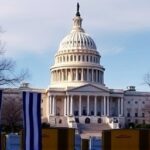As the end of the year rapidly approaches, U.S. Congress remains deeply divided over the renewal of critical Affordable Care Act subsidies, putting the health coverage of over 10 million Americans in jeopardy. Lawmakers from both parties have failed to bridge partisan gaps in recent negotiations, with the enhanced premium tax credits—set to expire on December 31—serving as a flashpoint in broader healthcare legislation debates. Without swift action, experts warn of skyrocketing insurance premiums and a potential surge in uninsured rates that could strain the U.S. economy.
Partisan Divide Deepens Over Subsidy Extension Costs
The impasse in Congress centers on the financial implications of extending the Affordable Care Act‘s enhanced healthcare subsidies, which were temporarily boosted under the 2021 American Rescue Plan to make insurance more affordable amid the COVID-19 pandemic. These subsidies have capped monthly premiums at 8.5% of household income for many enrollees, but their sunset could triple costs for low- and middle-income families. Republicans, led by Senate Minority Leader Mitch McConnell, argue that the program’s $64 billion annual price tag exacerbates federal deficits and burdens taxpayers, demanding offsets through cuts to other social programs.
Democrats, including House Speaker Nancy Pelosi, counter that allowing the subsidies to lapse would dismantle key pillars of the Affordable Care Act, pushing premiums up by an average of 75% in 2025 according to the Congressional Budget Office (CBO). “This isn’t just about numbers; it’s about lives,” Pelosi stated in a recent floor speech. “Failing to act means families choosing between healthcare and putting food on the table.”
Negotiations have stalled in the Senate Finance Committee, where a proposed bill to extend the subsidies through 2026 was blocked last week by a 12-10 party-line vote. Fiscal conservatives within the GOP, such as Sen. Rand Paul of Kentucky, have voiced strong opposition, citing the U.S. economy’s ongoing recovery from inflation as a reason to prioritize spending restraint. “We’re borrowing from our grandchildren to fund temporary fixes,” Paul tweeted, highlighting the broader tensions in healthcare legislation.
Behind the scenes, moderate Republicans like Sen. Susan Collins of Maine have pushed for compromises, suggesting a two-year extension tied to work requirements for able-bodied adults. However, progressive Democrats view such conditions as a non-starter, fearing they could disenroll vulnerable populations. This deadlock mirrors past battles over the Affordable Care Act, but with midterm elections looming, the stakes feel even higher for both sides.
Millions of Enrollees Brace for Premium Hikes and Coverage Gaps
For the 13.6 million Americans currently enrolled in Affordable Care Act marketplace plans—up 40% since the subsidies were enhanced— the potential loss of these healthcare subsidies represents a direct threat to financial stability. In states like California and New York, where enrollment is highest, advocates estimate that 2 million residents could lose access to affordable care if no deal is reached. The Kaiser Family Foundation reports that without the credits, a family of four earning $60,000 annually might see premiums jump from $500 to $1,500 per month.
Real-world stories underscore the urgency. In rural Georgia, single mother Maria Gonzalez, 34, relies on her ACA plan to cover treatments for her daughter’s asthma. “These subsidies are the only reason I can afford her inhalers and checkups,” Gonzalez shared in an interview with local reporters. “If they go away, we’ll be back to emergency rooms and debt.” Similar sentiments echo across the country, with AARP surveys showing 68% of adults over 50 fearing higher out-of-pocket costs.
Healthcare providers are also sounding alarms. The American Hospital Association (AHA) has warned that uncompensated care could rise by $50 billion nationwide, overwhelming understaffed facilities. Dr. David Hoyt, AHA’s executive vice president, emphasized in a statement: “The ripple effects of this congressional inaction will hit hospitals hardest, diverting resources from innovation to crisis management.” This comes as the U.S. economy grapples with labor shortages in healthcare, where uninsured patients often delay care until conditions worsen.
- Enrollment Surge: ACA marketplaces saw record sign-ups during open enrollment, with 21.3 million selecting plans—largely due to subsidies.
- State Variations: In expansion states, subsidies have reduced the uninsured rate by 7 percentage points; non-expansion states like Texas face steeper risks.
- Demographic Impact: Young adults and minorities, who make up 45% of enrollees, stand to lose the most.
Economists link these healthcare subsidies to broader U.S. economy stability, noting that affordable insurance reduces bankruptcies—over 500,000 annually are health-related—and boosts workforce participation. A study by the Urban Institute projects a 1.2% GDP dip if coverage lapses, as untreated illnesses sideline workers.
Broader Implications for U.S. Economy Amid Legislative Stalemate
The congressional deadlock on Affordable Care Act subsidies isn’t occurring in a vacuum; it’s intertwined with larger debates on U.S. economy priorities, including infrastructure funding and tax reforms. With federal debt surpassing $31 trillion, Republicans insist any extension must be revenue-neutral, potentially through repealing parts of the Inflation Reduction Act’s drug price negotiations. Democrats, however, see the subsidies as an investment yielding $1.50 in economic returns for every dollar spent, per Brookings Institution analysis.
Wall Street has taken notice, with health insurance stocks like UnitedHealth Group dipping 3% last week on subsidy uncertainty. Analysts at Moody’s Investors Service predict that premium volatility could inflate overall healthcare spending by 5-7%, contributing to persistent inflation pressures. “This legislation gridlock risks undoing years of progress in cost containment,” said Sarah Mimms, a senior economist at the firm.
On the state level, governors are scrambling. California’s Newsom administration has pledged $1 billion in emergency funds to mitigate impacts, while Florida’s DeSantis has criticized the Affordable Care Act as outdated, advocating for market-based alternatives. Bipartisan governors’ associations have urged Congress to act, warning of a “patchwork quilt” of state responses that could fragment the national healthcare system.
Public opinion polls reflect growing frustration. A recent Gallup survey found 62% of Americans support permanent subsidy extension, with approval crossing party lines at 55% among Republicans. Yet, trust in Congress to deliver remains low, at 18%, fueling calls for executive action from the White House—though legal experts doubt President Biden’s authority to unilaterally extend the credits without legislation.
Stakeholder Voices Amplify Calls for Bipartisan Breakthrough
From patient advocacy groups to business leaders, stakeholders are ramping up pressure on Congress to resolve the Affordable Care Act subsidy standoff. The Blue Cross Blue Shield Association, representing 33 million members, has lobbied intensively, with CEO Kim Keck testifying before the House Energy and Commerce Committee: “Lapsing these subsidies would not only harm individuals but destabilize the entire insurance market we’ve worked to build.”
Consumer advocates like those at Families USA highlight equity issues, noting that Black and Hispanic communities, which saw uninsured rates drop 50% under enhanced subsidies, would suffer disproportionately. “This is a civil rights issue disguised as fiscal policy,” argued executive director Candice Bowser in a virtual town hall. Small business owners, via the National Federation of Independent Business, express concerns over employee retention, as 25% of marketplace enrollees are self-employed or gig workers.
Even some conservative think tanks, like the Heritage Foundation, have softened stances, proposing targeted reforms over outright repeal. “Subsidies have proven effective in expanding coverage without the government takeover fears of old,” a policy brief read. This shift could open doors for compromise, though hardliners on both ends remain entrenched.
International comparisons add context: In Canada and the UK, universal systems avoid such subsidy cliffs, but U.S. lawmakers cite freedom of choice as paramount. Domestically, pilot programs in states like Colorado—offering state-funded subsidies—provide models, though scaling nationally requires federal legislation.
Path Forward: Deadlines, Scenarios, and Potential Reforms
With just weeks until the December 31 deadline, Congress faces a compressed timeline for Affordable Care Act subsidy renewal. The House is slated for a lame-duck session vote by mid-December, but Senate filibuster rules demand 60 votes for passage, necessitating Democratic unity and at least 10 GOP defections. Failure could trigger a 2025 open enrollment crisis, with experts forecasting 4-6 million dropping coverage.
Optimistic scenarios include a slimmed-down bill extending subsidies for one year, bundled with unrelated priorities like disaster relief. Pessimistic outlooks point to court challenges or administrative workarounds, though the Supreme Court’s conservative majority has historically scrutinized ACA expansions. Long-term, reformers advocate for permanent credits indexed to inflation, potentially saving $200 billion over a decade via efficiencies, per CBO estimates.
The U.S. economy hangs in the balance, as resolved legislation could stabilize premiums and support job growth in healthcare sectors employing 16 million. As negotiations intensify, all eyes are on key swing-state senators like Kyrsten Sinema of Arizona, whose vote could tip the scales. For millions, the message is clear: time is running out to safeguard the Affordable Care Act’s promise of accessible care.









